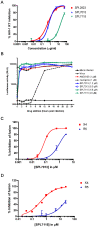Structure activity relationship of dendrimer microbicides with dual action antiviral activity
- PMID: 20808791
- PMCID: PMC2925893
- DOI: 10.1371/journal.pone.0012309
Structure activity relationship of dendrimer microbicides with dual action antiviral activity
Abstract
Background: Topical microbicides, used by women to prevent the transmission of HIV and other sexually transmitted infections are urgently required. Dendrimers are highly branched nanoparticles being developed as microbicides. However, the anti-HIV and HSV structure-activity relationship of dendrimers comprising benzyhydryl amide cores and lysine branches, and a comprehensive analysis of their broad-spectrum anti-HIV activity and mechanism of action have not been published.
Methods and findings: Dendrimers with optimized activity against HIV-1 and HSV-2 were identified with respect to the number of lysine branches (generations) and surface groups. Antiviral activity was determined in cell culture assays. Time-of-addition assays were performed to determine dendrimer mechanism of action. In vivo toxicity and HSV-2 inhibitory activity were evaluated in the mouse HSV-2 susceptibility model. Surface groups imparting the most potent inhibitory activity against HIV-1 and HSV-2 were naphthalene disulfonic acid (DNAA) and 3,5-disulfobenzoic acid exhibiting the greatest anionic charge and hydrophobicity of the seven surface groups tested. Their anti-HIV-1 activity did not appreciably increase beyond a second-generation dendrimer while dendrimers larger than two generations were required for potent anti-HSV-2 activity. Second (SPL7115) and fourth generation (SPL7013) DNAA dendrimers demonstrated broad-spectrum anti-HIV activity. However, SPL7013 was more active against HSV and blocking HIV-1 envelope mediated cell-to-cell fusion. SPL7013 and SPL7115 inhibited viral entry with similar potency against CXCR4-(X4) and CCR5-using (R5) HIV-1 strains. SPL7013 was not toxic and provided at least 12 h protection against HSV-2 in the mouse vagina.
Conclusions: Dendrimers can be engineered with optimized potency against HIV and HSV representing a unique platform for the controlled synthesis of chemically defined multivalent agents as viral entry inhibitors. SPL7013 is formulated as VivaGel(R) and is currently in clinical development to provide protection against HIV and HSV. SPL7013 could also be combined with other microbicides.
Conflict of interest statement
Figures





References
-
- UNAIDS. Joint United Nations Programme on HIV/AIDS (UNAIDS) and World Health Organisation (WHO). December 2007. AIDS Epidemic Update.
-
- Weller S, Davis K. Condom effectiveness in reducing heterosexual HIV transmission. Cochrane Database Syst Rev. 2002:CD003255. - PubMed
-
- Balzarini J, Van Damme L. Microbicide drug candidates to prevent HIV infection. Lancet. 2007;369:787–797. - PubMed
-
- Freeman EE, Weiss HA, Glynn JR, Cross PL, Whitworth JA, et al. Herpes simplex virus 2 infection increases HIV acquisition in men and women: systematic review and meta-analysis of longitudinal studies. AIDS. 2006;20:73–83. - PubMed
Publication types
MeSH terms
Substances
Grants and funding
LinkOut - more resources
Full Text Sources
Other Literature Sources

